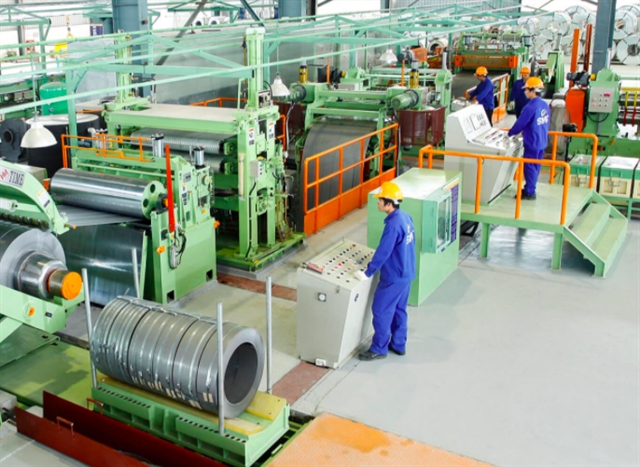With rising protectionist policies for the steel industry, and the US imposing tariffs on steel exports, the sector has entered a challenging period. In response, many industry giants are returning to the domestic market.

HÀ NỘI — Export challenges are prompting many major players in the steel industry to shift their focus back to the domestic market, putting additional pressure on trading companies that are already facing difficulties.
In previous years, many coated steel businesses focused on exports to expand their market share and production. This provided opportunities for local retailers and distributors to grow.
However, with rising protectionist policies for the steel industry, and the US imposing tariffs on steel exports, the sector has entered a challenging period. In response, many industry giants are returning to the domestic market.
The Đầu tư (Investment) newspaper quoted Lê Phước Vũ, chairman of the board of director of Hoa Sen Group, stated that exports accounted for over 60 per cent of the group's revenue in the past 10 years, mainly to the US, Europe and Southeast Asia.
However, due to global fluctuations, it would now focus on the domestic market, particularly expanding the Hoa Sen Home chain, said the chairman.
The group's revenue was evenly split between domestic and export sales in the first half of the 2023-2024 fiscal year. However, the domestic share rose to 62.6 per cent for the first half of the 2024-2025 fiscal year (from October 1 last year to March 31 this year).
Similarly, Hồ Minh Quang, Chairman of Nam Kim Steel Joint Stock Company, shared that the trade war had caused global markets to become unstable, and businesses were being more cautious, returning to the domestic market.
The company's domestic revenue accounted for 34.94 per cent last year, it had risen to 48 per cent but by the first quarter of 2025, he said.
Ton Dong A Corporation has also adjusted its strategy.
Nguyễn Thanh Trung, chairman of the board of directors, commented that Việt Nam was going through a period of administrative restructuring and was promoting investment in key infrastructure.
The real estate market is showing signs of recovery. The corporation had decided to raise its domestic revenue share to over 75 per cent from 41.16 per cent last year, he said, focusing on high-quality segments and areas that were previously neglected.
It is expected that when global trade stabilises by 2025-2026, Ton Dong A will adjust its sales strategy accordingly.
The corporation has raised its domestic market share to over 70 per cent as of May this year, and is continuing efforts to expand its domestic market share in the second half of the year.
The three industry giants including Hoa Sen, Nam Kim, and Ton Dong A, are actively returning to exploit the domestic market.

Challenges for trading companies
Before the major coated steel businesses returned to the domestic market, trading companies in the steel sector had already faced significant challenges.
In particular, companies supplying the real estate sector were dealing with capital lockups, having to sell below cost to handle high-priced inventory, resulting in prolonged losses.
At SMC Trading Investment Joint Stock Company, the company reported losses of VNĐ651.8 billion (US$26 million) in 2022 and VNĐ925.3 billion in 2023.
Despite continued difficulties in its core operations last year, SMC managed to escape losses through restructuring, asset liquidation, inventory clearance and converting debt into real estate.
However, its profit was only VNĐ126.8 million in the first quarter of this year, a year-on-year drop of 99.93 per cent.
The accumulated loss stood at VNĐ137.7 billion as of March 31 this year, equivalent to 18.7 per cent of its charter capital.
Notably, SMC used VNĐ854.5 billion of short-term capital to finance long-term assets, posing liquidity risks if its business performance continues to be weak.
Setting a target to increase revenue by 6.4 per cent to VNĐ9.5 trillion and raise profits by nearly 148 per cent to VNĐ30 billion this year, it still lacks a plan to raise funds to address its cash flow imbalance.
Meanwhile, Tien Len Steel Corporation Joint Stock Company has not experienced consecutive losses like SMC, but its business results remain weak.
It posted profits of only VNĐ7.5 billion in 2022, VNĐ4.1 billion in 2023, and a heavy loss of VNĐ597.7 billion last year.
The company made a profit of VNĐ2.98 billion in the first quarter of this year, significantly lower than the quarterly profits of over VNĐ30-100 billion in 2020-2021.
It still had an accumulated loss of VNĐ19.87 billion by the end of the first quarter of this year.
Both SMC and Tien Len Steel are trading companies with large amounts of unsold inventory. The return of production companies to the domestic market will place significant pressure on these trading firms, which are already struggling with financial difficulties and have yet to recover receivables from real estate partners from previous years. — VNS





